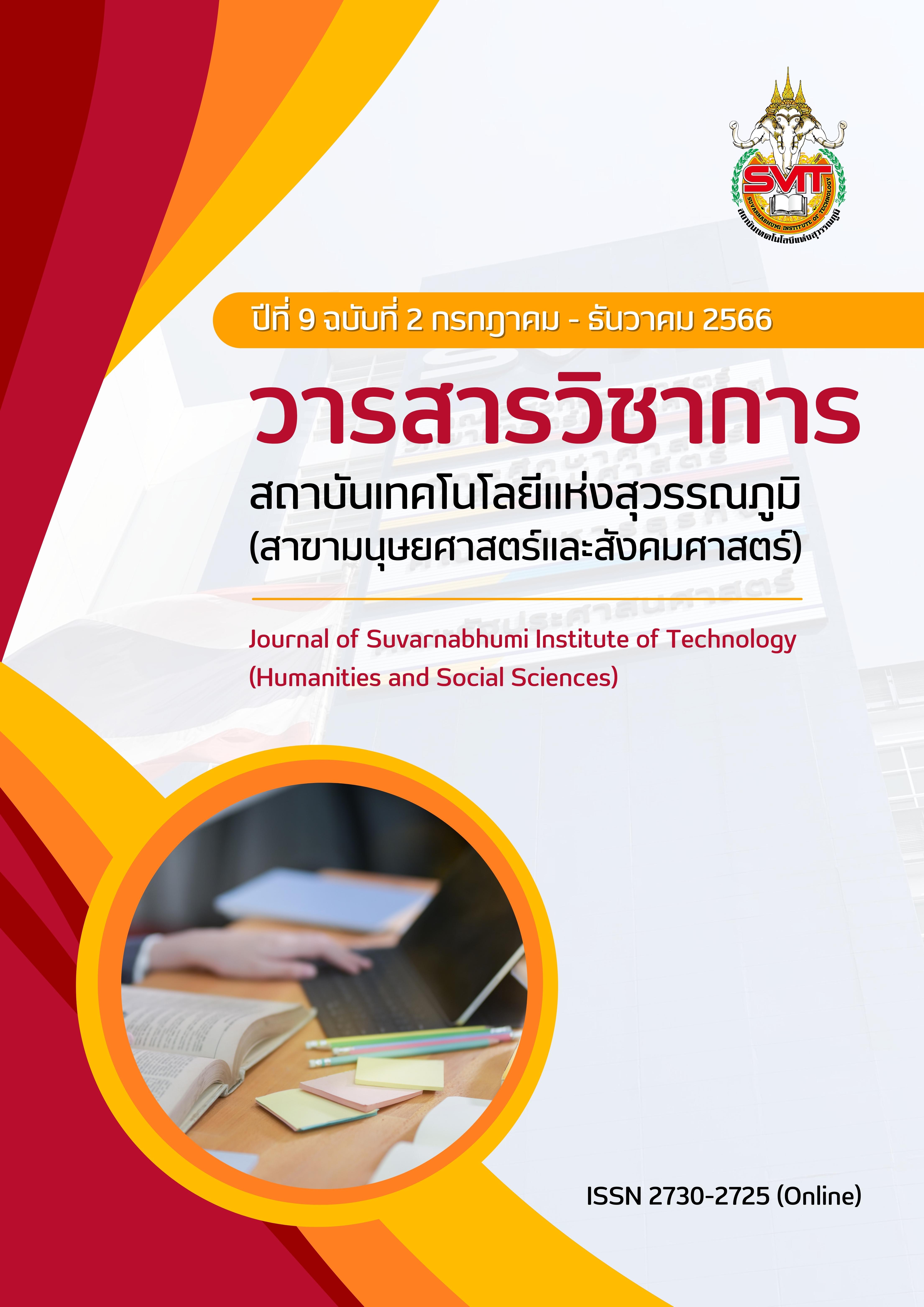FACTOR CLASSIFICATION AND GROUPING OF AWARENESS BEHAVIOR TOWARDS VACCINATION COVID-19 EPIDEMIC (COVID-19) OF THE ELDERLY IN BANG KHAE
Keywords:
Elderly, Awareness, Coronavirus Disease 2019 (COVID-19)Abstract
The objectives of this research are to analyze the main factors and grouping awareness behaviors on the vaccination against the epidemic of COVID-19 (COVID-19) of the elderly in Bangkok and its vicinity which the study sample It was a group of 400 elderly people aged 60 years and over in Bang Khae area, using a simple randomized method to collect the questionnaire characteristics that consisted of Awareness of the COVID-19 Pandemic defensive behavior and preparation before vaccination. In the study of the behavior of the samples, the frequency distribution method was used and the percentage of the answers received. For factor analysis of all 9 aspects of the principal component analysis with orthogonal rotation by Varimax method is used to extract the common components with the eigenvalues greater than or close to 0.5. The extracted components are then clustered using the K-Means technique.
The results showed that the sampling was aware that only one person infected with COVID-19 could transmit it to others, on average 2-4. Patients tended to have cough, fever, sore throat, breathlessness, chest tightness. to the point of death. Especially those with underlying diseases are at greatest risk. The main components of awareness were divided into 5 aspects: infection likelihood (Eigenvalues = 2.371 and Variance = 26.341 %), hygiene (Eigenvalues = 1.939 and Variance = 21.540 %), vaccine benefits (Eigenvalues =1.007 and Variance = 11.183 %), risk (Eigenvalues = 0.871 and Variance = 9.676 %), and obstacles to Vaccination (Eigenvalues = 0.750 and Variance = 8.338 %). The clustering from factor extraction It can be divided into 2 groups which are those who focus considering the severity of the Covid-19 virus (99.75 %) and those who focus considering vaccine efficacy (0.25 %). Therefore, both public and private agencies involved should focus more concretely on creating an understanding of both the virulence of virus and efficacy of the vaccine received.
References
กรมควบคุมโรค กระทรวงสาธารณสุข. (2564). แนวทางการป้องกันและควบคุมโรคไวรัสโคโรนา 2019 สำหรับประชาชน. นนทบุรี: กระทรวงสาธารณสุข.
กรมควบคุมโรค กระทรวงสาธารณสุข. (2564). รายงานโรคไวรัสโคโรนา 2019. นนทบุรี: กระทรวงสาธารณสุข
กัญญาภัค ประทุมชมภู. (2559). ปัจจัยแรงจูงใจในการป้องกันโรคที่มีผลต่อการรับบริการฉีดวัคซีนไข้หวัดใหญ่ในผู้สูงอายุ ตำบลแสนสุข อำเภอเมืองชลบุรี จังหวดชลบุรี. (วิทยานิพนธ์ปริญญามหาบัณฑิต, มหาวิทยาลัยบูรพา).
ชุติมา บุญทวี. (2565). ปัจจัยที่ส่งผลต่อการตัดสินใจฉีดวัคซีนป้องกัน โคโรนา ไวรัส (COVID-19) เข็มกระตุ้น ของบุคลากรกลุ่มงานพยาบาลโรงพยาบาลตำรวจ. วารสารวิจัยเพื่อการส่งเสริมสุขภาพและคุณภาพ ชีวิต, 2(2), 49-60.
นภชา สิงห์วีรธรรม เพ็ญนภา ศรีหริ่ง อรนุช ทองจันดี วุฒิกุล ธนากาญจนภักดี อัจฉรา คำมะทิตย์ และกิตติพร เนาว์สุวรรณ. (2565). ความเต็มใจยอมรับและความเต็มใจที่จะจ่ายเงินการได้รับการฉีด วัคซีนกระตุ้นซ้ำป้องกันโรคติดเชื้อไวรัสโคโรนา 2019. สืบค้นจากhttps://kb.hsri.or.th/dspace/handle/11228/5547?locale- attribute=th
บวรลักษณ์ ขจรฤทธิ์ และบุฏกา ปัณฑุรอัมพร. (2563). ปัจจัยที่ส่งผลต่อการตัดสินใจฉีดวัคซีนป้องกันโควิด-19 ของประชากรในจังหวัดสมุทรปราการ. สืบค้นจาก
https://mmm.ru.ac.th/MMM/IS/sun18/6214070058.pdf
ประภาเพ็ญ สุวรรณ. (2520). ทัศนคติ:การวัดการเปลี่ยนแปลงและพฤติกรรมอนามัย. (พิมพ์ครั้งที่1).กรุงเทพฯ: ไทยวัฒนาพาณิชย์.
ปภัสนันท์ ชมจันทึก. (2561). พฤติกรรม การ เปิด รับ ทัศนคติ และ กระบวนการ ตัดสินใจ ท่องเที่ยวตามแฮ ชแท็ก ท่องเที่ยวบน ทวิตเตอร์. (วิทยานิพนธ์ปริญญามหาบัณฑิต, มหาวิทยาลัยธรรมศาสตร์).
ไพรัชฌ์ สงคราม จักรสันต์ เลยหยุด พรรณิภา ไชยรัตน์ มิ่งขวัญ ภูหงส์ทอง ชัญญรัชต์ นกศักดา และวิราสินี สีสงคราม. (2564). ความต้องการวัคซีนโควิด-19 และปัจจัยที่มีความสัมพันธ์กับความพร้อมของบุคลากรสาธารณสุขในการบริการวัคซีนโควิด-19 จังหวัดขอนแก่น. วารสารวิชาการสาธารณสุข, 30(ฉบับเพิ่มเติม 2 กรกฎาคม - สิงหาคม 2564), 199-207.
ไมตรี ธนประสิทธิ์พัฒนา. (2561). ผลของโปรแกรมการส่งเสริมความรู้และความตระหนักเกี่ยวกับการป้องกันโรคพิษสุนัขบ้าของอาสาสมัครสาธารณสุขประจำหมู่บ้าน ตำบลหนองตาคง อำเภอโป่งน้ำร้อน จังหวัดจันทบุรี. จันทบุรี: สำนักงานสาธารณสุขจังหวัดจันทบุรี.
วิชัย วงษ์ใหญ่. (2525). พัฒนาหลักสูตรการสอน. มิติใหม่ (พิมพ์ครั้งที่ 3). กรุงเทพฯ: โอเดียนสโตร์.
ศิริพร วามะศิริ. (2560). คลิปสปอนเซอร์ กับการเปิดรับข่าวสารทัศนคติ และการตัดสินใจซื้อผลิตภัณฑ์ความงาม:กรณีศึกษาบิวตี้บล็อกเกอร์ Mayyr. (วิทยานิพนธ์ปริญญามหาบัณฑิต, มหาวิทยาลัยธรรมศาสตร์).
สาโรจน์ นาคจู. (2564). พฤติกรรมการป้องกันตนเองจากการติดเชื้อไวรัสโคโรนา 2019 (COVID-19) ของ ประชาชน ใน กรุงเทพมหานคร. The Journal of Pacific Institute of Management Science (Humanities and Social Science), 7(3), 151-160.
สุภาภรณ์ วงธิ. (2564). ปัจจัยที่ส่งผลต่อพฤติกรรมการป้องกันโรคติดเชื้อไวรัสโคโรนา 2019 ของอาสาสมัครสาธารณสุขประจำหมู่บ้าน จังหวัดสุโขทัย. (วิทยานิพนธ์ปริญญามหาบัณฑิต,มหาวิทยาลัยนเรศวร).
สร้อยตระกูล (ติวยานนท์) อรรถมานะ. (2541). พฤติกรรมองค์การ : ทฤษฎีและการประยุกต์. กรุงเทพฯ: สำนักพิมพ์มหาวิทยาลัยธรรมศาสตร์.
Cochran, W.G. (1977) Sampling Techniques. (3rded). New York: John Wiley & Sons.
Wongratana, C. (2010). Techniques for using statistics for research. Nontaburi: Thainiramitkij Infographic.
Downloads
Published
Issue
Section
License
Copyright (c) 2023 Suvarnabhumi Institute of Technology

This work is licensed under a Creative Commons Attribution-NonCommercial-NoDerivatives 4.0 International License.
บทความที่ได้รับการตีพิมพ์เป็นลิขสิทธิ์ของวารสารวิชาการ สถาบันเทคโนโลยีแห่งสุวรรณภูมิ
ข้อความที่ปรากฏในบทความแต่ละเรื่องในวารสารวิชาการเล่มนี้เป็นความคิดเห็นส่วนตัวของผู้เขียนแต่ละท่านไม่เกี่ยวข้องกับสถาบันเทคโนโลยีแห่งสุวรรณภูมิ และคณาจารย์ท่านอื่นๆในสถาบันฯ แต่อย่างใด ความรับผิดชอบองค์ประกอบทั้งหมดของบทความแต่ละเรื่องเป็นของผู้เขียนแต่ละท่าน หากมีความผิดพลาดใดๆ ผู้เขียนแต่ละท่านจะรับผิดชอบบทความของตนเองแต่ผู้เดียว





